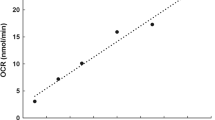Summary
The ascaricidal effect of oxygen is related to accumulation of hydrogen peroxide formed as an aerobic metabolite under conditions of low catalase activity. Stimulation of motor activity of the ascarids by immersion in santonin or piperazine solutions or by galvanic current abolishes catalase activity, and thus shortens survival time during exposure to oxygen. Conversely, abolition of motor activity by immersion in chloral hydrate solutions ralses catalase activity, and prolongs survival time. Preliminary administration of small doses of santonin or piperazine should enhance the effectiveness of oxygen therapy for ascaridosis.
Similar content being viewed by others
Literature Cited
N. P. Kravets, Med. Parazitol. No. 2, 122–124 (1951).
N. P. Kravets, Biull. Biol. i Med. No. 1, 85–88 (1957). Original Russian pagination. See C. B. Translation.
A. I. Krotov, Med. Parazitol. No. 5, 387–395 (1953).
A. I. Krotov, Papers Presented at the Ninth Congress on Problems of Parasitology, pp. 121–122 (Moscow, 1957).
A. I. Krotov, Med. Parazitol. No. 2, 185–193 (1957).
A. I. Krotov, Med. Parazitol. No. 3, 284–289 (1957).
H. Laser, Biochem. J. 1944, v. 38, pp. 333–338.
Author information
Authors and Affiliations
Rights and permissions
About this article
Cite this article
Krotov, A.I. Effect of physiological condition of ascarids on their survival time in an atmosphere of oxygen. Bull Exp Biol Med 46, 996–998 (1958). https://doi.org/10.1007/BF00787343
Received:
Issue Date:
DOI: https://doi.org/10.1007/BF00787343



